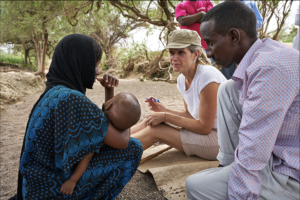Charlotte Mikkelborg is a British producer and director using virtual reality technology to create immersive narrative experiences. Her character-driven experience Born into Exile (2016), a story of two Syrian refugees, was screened in the United States Houses on Congress, and The Journey (2018) premiered at SXSW and won the 61st Cine Golden Eagle Award for Best VR Short.
KrASIA spoke with Mikkelborg about her groundbreaking, emotive work in her chosen medium. The following interview was edited for brevity and clarity.

KrASIA (Kr): The United Nations was one of the investors in Born into Exile. What potential did they see in the use of VR?
Charlotte Mikkelborg (CM): The UN was actually a heavy investor in VR content since the fairly early days. VR is terminally referred to as an empathy machine, and they ran a test project where random pedestrians on the street were asked to sample humanitarian VR content and found that the number of people willing to donate doubled. There’s always a crisis somewhere in the world, and there’s always someone suffering, but news cycles are so constant that largely you feel quite immune to it. VR lets you enter these environments and feel yourself in the same physical space, which is so much more powerful.
Within a few minutes of watching The Journey, some viewers burst into tears, and the film is not even meant to be sad, but rather about hope and possibility. The technology can put you in another person’s shoes, which can be educational and inspirational at the same time.
Kr: When you were on the ground creating The Journey in Ethiopia, did your main subjects know that the film would be a VR experience and not an average documentary?
CM: Considering the language barrier, trying to describe the project and technology was not really doable and didn’t do the content justice. We decided that the best way to communicate our goal was to let them see it for themselves. We let our 10-year-old and 17-year-old contributors try out the headset and they were really amazed by the experience. After that moment, they had a much clearer understanding of what we were doing, and their excitement only increased. In the end, we were able to create a really powerful project that evoked people’s emotions.
Kr: What is it like for VR creators to seek investment and funding?
CM: The sources of funding in the VR industry are all over the place. Unlike the traditional film industry, which has established funding channels, investment in VR content comes from a variety of organizations. There is plenty of public funding in Europe, in places like the UK and France. NGOs like UNICEF or organizations like United Nations also have an interest in backing humanitarian content projects. Then you have game engine companies like Unity and Unreal that are investing in the technology for gaming and entertainment applications. Hopefully, as the industry matures there will be more fixed channels for creators to raise capital.
Kr: Can you talk about the potential for VR to rejuvenate historical studies?
CM: The potential is almost limitless, because there are so many fascinating events and characters and periods from history to explore. I think the only challenge is budgetary. How much money can you commit to a specific endeavor? Ultimately, money means time to research, and research is the key. But who wouldn’t want to live in the day in the Roman Forum or go back and witness Wilbur Wright pilot the first flight on Kitty Hawk Beach? There are also plenty of uses for augmented reality technology when it comes to recreating history. You can create layers on top of a real environment, like in one project I worked on called “Tudors Augmented.”
Kr: What are the major barriers to the VR industry’s development?
CM: There are still a very limited number of VR headsets compared to TVs and mobile phones, even in rich countries. In the developing world, even in fairly well-developed countries like Nigeria and Kenya, their VR industry is non-existent. Getting access to VR headsets in these places is difficult, and most VR projects are already on tight budgets. We shot part of The Journey in Chad, and while the trip didn’t cost much, I wish we had the resources to show the content to the local communities who had helped us produce it. If we can expand the technology to mobile phones, then we can reach more users around the world.
Read this: Leia brings 3D holograms to life | Inside China’s Startups





